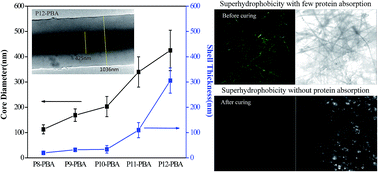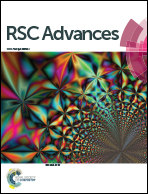Using coaxial electrospinning to fabricate core/shell-structured polyacrylonitrile–polybenzoxazine fibers as nonfouling membranes†
Abstract
In this study we used coaxial electrospinning to produce core/shell polyacrylonitrile (PAN)–polybenzoxazine (PBA) fibers. We employed PAN and BA liquid, both in DMF, to form the inner (core) and outer (shell) layers, respectively, generating uniformly sized, defect-free fibers having diameters of 250–1290 nm. The PAN–PBA core/shell fibers that we obtained after curing at 300 °C for 2 h exhibited low surface free energies. We obtained five sets of mats—each with a different core diameter, shell thickness, and physical properties—by varying the concentration of PAN from 8 to 12 wt% and then studied the effects of the fiber diameter on the pore size distribution, the static water contact angle (SWCA), and the liquid water entry pressure of the fabricated membranes. We also tested these membranes for their nonfouling properties through direct contact membrane adsorption of proteins. We found that the PAN–BA core/shell fibrous membranes having high hydrophobicity (SWCA > 150°) prior to curing displayed significant degrees of protein attachment. After curing, however, the fouling properties of the PAN–PBA fibrous membranes disappeared completely—the result of generating PBA with a low surface free energy. The fabrication of such core/shell PAN–PBA fibers through coaxial electrospinning suggests the further design and development of fibers of low surface free energy, without the need for fluorine and silicon elements, with improved fouling-resistant properties.


 Please wait while we load your content...
Please wait while we load your content...